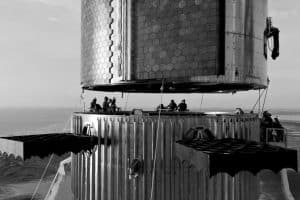CEO Elon Musk has published the first official visualization of what SpaceX’s plans to catch Super Heavy boosters might look like in real life. However, the simulation he shared raises just as many questions as it answers.
Since at least late 2020, SpaceX CEO Elon Musk has been floating the idea of catching Starships and Super Heavy boosters out of the sky as an alternative to having the several-dozen-ton steel rockets land on a basic concrete with legs. This would be a major departure from SpaceX’s highly successful Falcon family, which land on a complex set of deployable legs that can be retracted after soft landings. The highly flexible, lightweight structures have mostly been reliable and easily reusable but Falcon boosters occasionally have rough landings, which can use up disposable shock absorbers or even damage the legs and make boosters hard to secure.
As a smaller rocket, Falcon boosters have to be extremely lightweight to ensure healthy payload margins and likely weigh about 25-30 tons empty and 450 tons fully fueled – an excellent mass ratio for a reusable rocket. While it’s still good to continue that practice of rigorous mass optimization with Starship, the vehicle is an entirely different story. Once plans to stretch the Starship upper stage’s tanks and add three more Raptors are realized, it’s quite possible that the Starship vehicle will be capable of launching more than 200 tons (~440,000 lb) of payload to low Earth orbit (LEO) with ship and booster recovery.
One might think that SpaceX, with the most capable rocket ever built potentially on its hands, might take advantage of that unprecedented performance to make the rocket itself – also likely to be one of the most complex launch vehicles ever – simpler and more reliable. Generally speaking, that would involve sacrificing some of its payload capability and adding systems that are heavier but simpler and more robust. Once Starship is regularly flying to orbit and providing lots of flight experience and data, SpaceX might then be able refine the rocket, gradually reducing its mass and improving payload to orbit by optimizing or fully replacing suboptimal systems and designs.
Instead, SpaceX appears to be trying to substantially optimize Starship before it’s attempted a single orbital launch. The biggest example is Elon Musk’s plan to catch Super Heavies – and maybe Starships, too – for the sole purpose of, in his own words, “[saving] landing leg mass [and enabling] immediate reflight of [a giant rocket].” Musk, SpaceX executives, or both appear to be attempting to refine a rocket that has never flown. Unfortunately, based on a simulation of a Super Heavy “catch” Musk shared on January 20th, all that oddly timed effort may end up producing a solution that’s actually worse than what it’s trying to replace.
Based on the simulated telemetry shown in the visualization, Super Heavy’s descent to the landing zone appears to be considerably gentler than the ‘suicide burn’ SpaceX routinely uses on Falcon. By decelerating as quickly as possible and making landing burns as short as possible, Falcon saves a considerable amount of propellant during recovery – extra propellant that, if otherwise required, would effectively increase Falcon’s effective dry mass and decrease its payload to orbit. In the Super Heavy “catch” SpaceX has shown, the booster actually appears to be landing – just on an incredibly small patch of steel on the arms instead of a concrete pad on the ground.
Aside from a tiny bit of lateral motion, the arms appear motionless during the ‘catch,’ making it more of a landing. Further, Super Heavy is decelerating rather slowly throughout the simulation and appears to hover for almost 10 seconds near the end. That slow, cautious descent and even slower touchdown may be necessary because of how incredibly accurate Super Heavy has to be to land on a pair of hardpoints with inches of lateral margin for error and maybe a few square feet of usable surface area. The challenge is a bit like if SpaceX, for some reason, made Falcon boosters land on two elevated ledges about as wide as car tires. Aside from demanding accurate rotational control, even the slightest later deviation would cause the booster to topple off the pillars and – in the case of Super Heavy – fall about a hundred feet onto concrete, where it would obviously explode.
What that slow descent and final hover mean is that the Super Heavy landing shown would likely cost significantly more delta V (propellant) than a Falcon-style suicide burn. Propellant has mass, so Super Heavy would likely need to burn at least 5-10 tons more to carefully land on arms that aren’t actively matching the booster’s position and velocity. Ironically, SpaceX could probably quite easily add basic, fixed legs – removing most of the bad aspects of Falcon legs – to Super Heavy with a mass budget of 10 tons. But even if SpaceX were to make those legs as simple, dumb, and reliable as physically possible and they wound up weighing 20 tons total, the inherent physics of rocketry mean that adding 20 tons to Super Heavy’s likely 200-ton dry mass would only reduce the rocket’s payload to orbit by about 3-5 tons or 1-3%.
Further, per Musk’s argument that landing on the arms would enhance the speed of reuse, it’s difficult to see how landing Super Heavy or Starship in the exact same corridor – but on the ground instead of on the arms – would actually change anything. If Super Heavy is accurate enough to land on about a square meter of motionless arms, it must inherently be accurate enough to land within the far larger breadth of those arms. The only process landing on the arms would obviously remove is reattaching the arms to a landed booster or ship, which it’s impossible to imagine would save more than a handful of minutes or maybe an hour of work. SpaceX’s Falcon booster turnaround record is currently 27 days, so it’s difficult to imagine why SpaceX would be worrying about cutting minutes or a few hours off of the turnaround and reuse of a rocket that has never even performed a full static fire test – let alone attempted an orbital-class launch, reentry, or landing.
Put simply, while Starbase’s launch tower arms will undoubtedly be useful for quickly lifting and stacking Super Heavy and Starship, it’s looking more and more likely that using those arms as a landing platform will, at best, be an inferior alternative to basic Falcon-style landings. More importantly, even if everything works perfectly, the arms actually cooperate with boosters to catch them, and it’s possible for Super Heavy to avoid hovering and use a more efficient suicide burn, the best-case outcome is marginally faster reuse and perhaps a 5% increase in payload to orbit. Only time will tell if such a radical change proves to be worth such marginal benefits.





